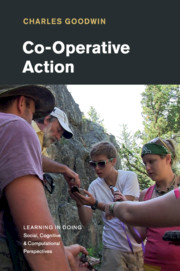Book contents
- Co-Operative Action
- Learning in Doing: Social, Cognitive and Computational Perspectives
- Co-Operative Action
- Copyright page
- Dedication
- Contents
- Figures
- Acknowledgments
- 1 What Is Co-Operative Action, and Why Is It Important?
- Part I Co-Operative Accumulative Action
- Part II Intertwined Semiosis
- Part III Embodied Interaction
- Part IV Co-Operative Action with Predecessors
- Part V Professional Vision, Transforming Sensory Experience into Types, and the Creation of Competent Inhabitants
- 20 The Emergence of Conventionalized Signs within the Natural World
- 21 Calibrating Experience and Knowledge by Touching the World Together
- 22 The Blackness of Black
- 23 Building Skilled, Knowing Actors and the Phenomenal Objects They Are Trusted to Know
- 24 Professional Vision
- 25 Conclusion
- References Cited
- Index
- Series page
24 - Professional Vision
from Part V - Professional Vision, Transforming Sensory Experience into Types, and the Creation of Competent Inhabitants
Published online by Cambridge University Press: 03 November 2017
- Co-Operative Action
- Learning in Doing: Social, Cognitive and Computational Perspectives
- Co-Operative Action
- Copyright page
- Dedication
- Contents
- Figures
- Acknowledgments
- 1 What Is Co-Operative Action, and Why Is It Important?
- Part I Co-Operative Accumulative Action
- Part II Intertwined Semiosis
- Part III Embodied Interaction
- Part IV Co-Operative Action with Predecessors
- Part V Professional Vision, Transforming Sensory Experience into Types, and the Creation of Competent Inhabitants
- 20 The Emergence of Conventionalized Signs within the Natural World
- 21 Calibrating Experience and Knowledge by Touching the World Together
- 22 The Blackness of Black
- 23 Building Skilled, Knowing Actors and the Phenomenal Objects They Are Trusted to Know
- 24 Professional Vision
- 25 Conclusion
- References Cited
- Index
- Series page
Summary
Discursive practices that are used by members of a profession to shape events in the domains subject to their professional scrutiny create the objects of knowledge that become the insignia of a profession’s craft: the theories, artifacts, and bodies of expertise that distinguish it from other professions. The 1992 trial of four police officers videotaped beating an African-American motorist became a politically charged theater of contested vision. Opposing sides in the case used the murky pixels of the same television image to display to the jury incommensurate events: a brutal, savage beating of a man lying helpless on the ground versus careful police response to a dangerous “PCP-crazed giant.” The lawyers successfully defending the policemen used many of the practices examined in earlier chapters, including highlighting, coding, and graphic annotation, to shape what the jury could see on the tape as proper police response to a dangerous suspect, rather than the beating of a helpless man. The Rodney King trial provides a vivid example of how the ability to see a meaningful event is not a transparent, psychological process but instead a socially situated activity accomplished through the deployment of a range of historically constituted discursive practices.
* * *
- Type
- Chapter
- Information
- Co-Operative Action , pp. 407 - 428Publisher: Cambridge University PressPrint publication year: 2017

